The Nvidia GeForce RTX 40 series graphics card family has expanded further with the launch of the GeForce RTX 4070. The card sits below the GeForce RTX 4070 Ti in the series and is a cut-down version of the RTX 4070 Ti. RTX 4070 is a powerful mid-range graphics card that is targeted for 1440p gaming at maximum settings. However, the card is powerful enough to run the latest AAA games on high settings at 4k resolution while delivering 60+ FPS. The main competitors of RTX 4070 are the Radeon RX 6800 XT from AMD and RTX 3080, an older high-end graphics card from Nvidia built on the Ampere architecture. The gaming performance of these cards is very close to each other but some key differences set them apart. So, if you want to find out how the RTX 4070 stacks against the RX 6800 XT and RTX 3080 then below is a comparison of these cards on important parameters.
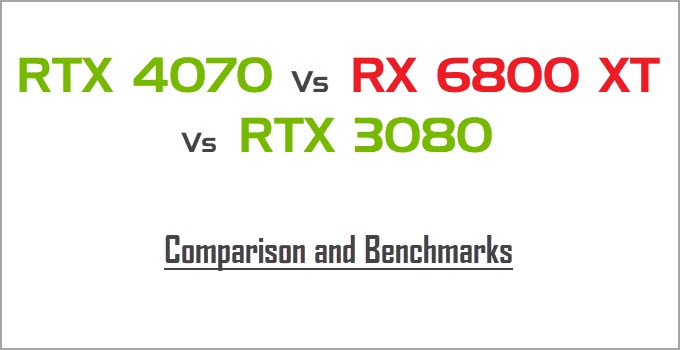
Note: The below comparison is made using the original RTX 3080 card that comes with 10 GB VRAM. RTX 3080 also comes with 12GB VRAM and slightly more CUDA Cores. The 12GB RTX 3080 version is only slightly faster than the 10 GB RTX 3080.
RTX 4070 vs RX 6800 XT vs RTX 3080 Comparison
Below is a comprehensive comparison between RTX 4070, RX 6800 XT, and RTX 3080 graphics cards based on their specifications, performance, pricing, power consumption, and features.
GPU Architecture
RTX 4070 is powered by the latest Ada Lovelace GPU architecture and is built on the TSMC 4nm manufacturing process. The card uses a cut-down version of AD104 GPU with some shading units or cores disabled. It comes with 5888 CUDA Cores, 46 RT Cores (3rd Gen.), and 184 Tensor Cores (4th Gen.). On the other hand, RTX 3080 is built on the relatively older Ampere architecture on an 8nm manufacturing process. The card uses 8704 CUDA Cores, 68 RT Cores (2nd Gen.), and 272 Tensor Cores (3rd Gen.). The performance of higher generation RT Cores and Tensor Cores is better than older generation RT Cores and Tensor Cores.
AMD Radeon RX 6800 XT is built on the RDNA 2 architecture on a 7nm fabrication process. The card uses Navi 21 GPU and comes with 4608 Stream Processors, 72 Ray Accelerators, or RT Cores and there are no Tensor Cores on this card.
Must Read: CUDA Cores vs Stream Processors Difference
| RTX 4070 | RX 6800 XT | RTX 3080 | |
| GPU Chip | AD104 | Navi 21 | GA102 |
| GPU Architecture | Ada Lovelace | RDNA 2 | Ampere |
| Fabrication Process | 4nm | 7nm | 8nm |
| CUDA Cores/Stream Processors | 5888 CUDA Cores | 4608 Stream Processors | 8704 CUDA Cores |
| RT Cores | 46 (3rd Generation) | 72 | 68 (2nd Generation) |
| Tensor Cores | 184 (4th Generation) | NA | 272 (3rd Generation) |
Video RAM [VRAM]
RX 6800 XT comes with 16 GB GDDR6 memory which is the highest among the three cards here. The memory has a 256-bit interface and runs at a speed of 16 Gbps. The memory bandwidth delivered is 512 GB/s but it can achieve a much higher peak memory bandwidth of 1664 GB/s (3.25x effective bandwidth) using 128MB Infinity Cache, an ultra-fast cache memory present on the GPU. RTX 4070 comes with 12GB GDDR6X memory with a 192-bit interface. The memory runs at a speed of 21 Gbps and delivers a bandwidth of 504 GB/s. The card with the lowest amount of memory is RTX 3080 but it has got the highest memory bandwidth. It comes with 10 GB GDDR6X memory having a 320-bit interface. The memory runs at a speed of 19 Gbps and delivers a memory bandwidth of 760 GB/s.
Note: There is also a 12GB version of RTX 3080 but here we are using the reference 10GB RTX 3080 version.
| RTX 4070 | RX 6800 XT | RTX 3080 | |
| Memory Size | 12 GB GDDR6X | 16 GB GDDR6 | 10 GB GDDR6X |
| Memory Interface | 192-bit | 256-bit | 320-bit |
| Memory Speed | 21 Gbps | 16 Gbps | 19 Gbps |
| Memory Bandwidth | 504 GB/s | 512 GB/s | 760 GB/s |
| Infinity Cache | NA | 128 MB | NA |
Features
All three graphics cards come with the latest technologies and support DirectX 12 Ultimate, OpenGL 4.6, and Vulkan and support variable refresh rate technologies (G-Sync/FreeSync) to reduce stuttering in games for a smoother gaming experience, PCIe 4.0, Real-Time Ray Tracing, HDMI 2.1, AV1 decode. When it comes to image upscaling technology to increase performance/FPS in games, RTX 4070 and RTX 3080 support DLSS (Deep Learning Super Sampling). RTX 4070 supports the latest version of DLSS which is DLSS 3 while RTX 3080 supports DLSS 2. On the other hand, Radeon RX 6800 XT supports AMD FidelityFX Super Resolution (FSR) image upscaling technology for games.
| RTX 4070 | RX 6800 XT | RTX 3080 | |
| Bus Interface | PCI Express 4.0 | PCI Express 4.0 | PCI Express 4.0 |
| DirectX | 12 Ultimate | 12 Ultimate | 12 Ultimate |
| OpenGL | 4.6 | 4.6 | 4.6 |
| Vulkan | 1.2 | 1.2 | 1.2 |
| SLI / CrossFire | NA | NA | NA |
| VR Ready | Yes | Yes | Yes |
| G-Sync/FreeSync | Yes | Yes | Yes |
| HDMI 2.1 | Yes | Yes | Yes |
| DisplayPort 2.1 | No | No | No |
| AV1 Support (Encode/Decode) | Yes | Yes | Yes |
| Real-Time Ray Tracing | Yes | Yes | Yes |
| Deep Learning Super Sampling (DLSS) | DLSS 3 | NA | DLSS 2 |
| FidelityFX Super Resolution (FSR) | NA | FSR 2 | NA |
Gaming Performance
Here are the gaming benchmarks of these cards at 1440p and 4K resolution in the latest AAA games.
1440p Gaming Benchmarks
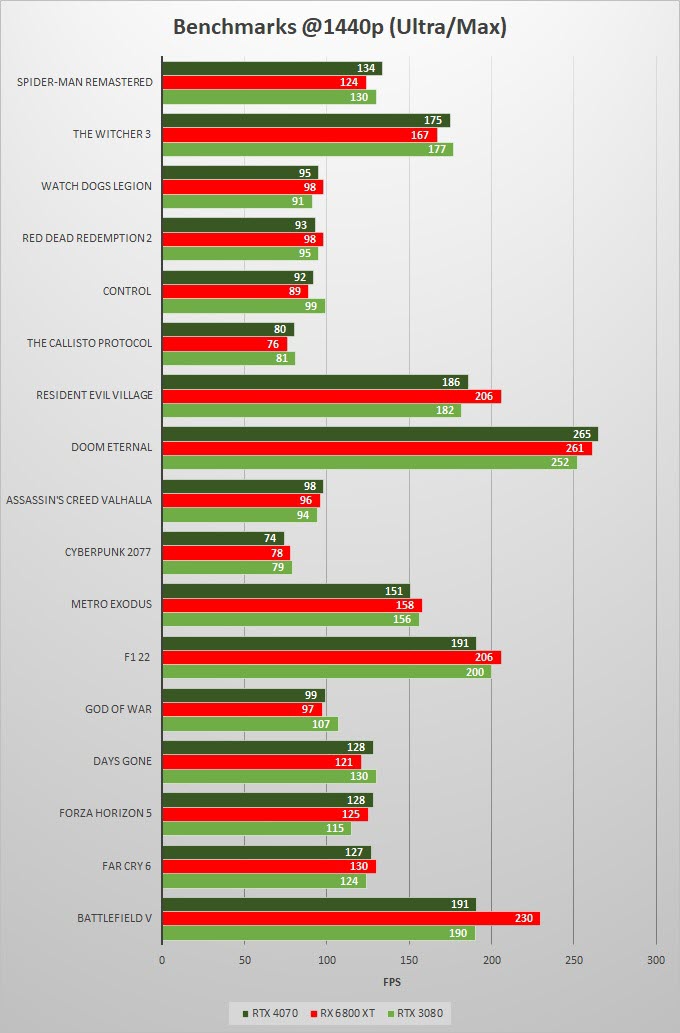
At 1440p resolution, all three cards deliver almost the same level of performance. They might differ in a few FPS in each game but on average, the performance is nearly the same with all games combined.
4K Gaming Benchmarks
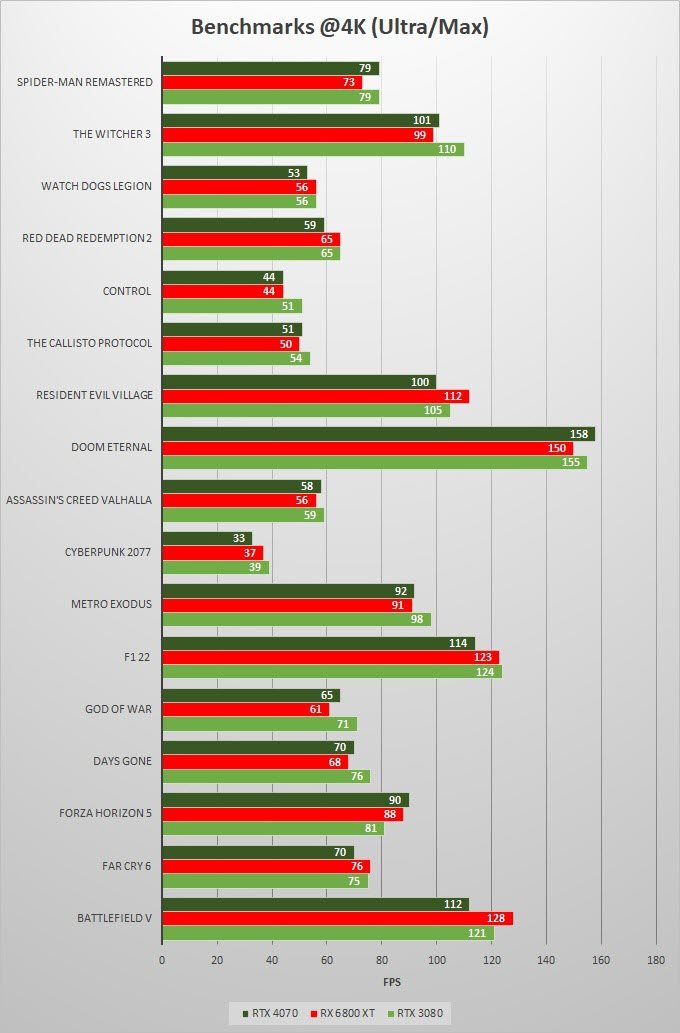
At 4K resolution, RTX 4070 is around 5 percent slower than RTX 3080 (on average) but is on par with RX 6800 XT.
Ray Tracing Gaming Bechmarks@1440p
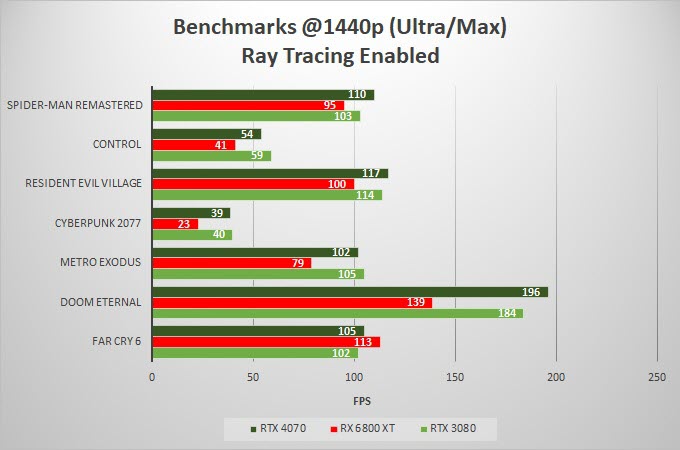
When Ray Tracing is enabled in supported games then RTX 4070 does come faster of all three cards while RX 6800 XT is the slowest of all.
Power Consumption
RTX 4070 is the most power-efficient card of the three with having maximum power consumption rating of 200W. On the other hand, RTX 3080 and RX 6800 XT have significantly higher power consumption and has maximum power consumption figure of 320W and 300W respectively.
| RTX 4070 | RX 6800 XT | RTX 3080 | |
| Power Consumption | 200W | 300W | 320W |
| Recommended PSU | 650W | 750W | 750W |
Pricing & Availability
The official MSRP of RTX 4070 is $599 while that of RTX 3080 is $699. The RX 6800 XT has an official pricing of $649 at the time of launch but now it has become cheaper and you can find it below USD 600 quite easily on online stores. You can check the latest prices of these cards from the links given below.
Check RTX 4070 Price on Amazon
Check RX 6800 XT Price on Amazon
Check RTX 3080 Price on Amazon
RTX 4070 vs RX 6800 XT vs RTX 3080 Specifications
| RTX 4070 | RX 6800 XT | RTX 3080 | |
| GPU Chip | AD104 | Navi 21 | GA102 |
| GPU Architecture | Ada Lovelace | RDNA 2 | Ampere |
| Fabrication Process | 4nm | 7nm | 8nm |
| CUDA Cores/Stream Processors | 5888 CUDA Cores | 4608 Stream Processors | 8704 CUDA Cores |
| RT Cores | 46 | 72 | 68 |
| Tensor Cores | 184 | NA | 272 |
| Memory Size | 12GB GDDR6X | 16 GB GDDR6 | 10 GB GDDR6X |
| Memory Interface | 192-bit | 256-bit | 320-bit |
| Memory Speed | 21 Gbps | 16 Gbps | 19 Gbps |
| Memory Bandwidth | 504 GB/s | 512 GB/s | 760 GB/s |
| Bus Interface | PCI Express 4.0 | PCI Express 4.0 | PCI Express 4.0 |
| DirectX | 12 Ultimate | 12 Ultimate | 12 Ultimate |
| OpenGL | 4.6 | 4.6 | 4.6 |
| Vulkan | 1.2 | 1.2 | 1.2 |
| SLI / CrossFire | NA | NA | NA |
| VR Ready | Yes | Yes | Yes |
| G-Sync/FreeSync | Yes | Yes | Yes |
| Power Consumption | 200W | 300W | 320W |
| Recommended PSU | 650W | 750W | 750W |
Final Thoughts
Well, RTX 4070 is a very good card especially if you play games on 1440p resolution with all graphics settings turned to maximum. The card is also very energy efficient and consumes significantly less power compared to its competitors. Also, it does come with all the latest features and technologies that help to make your gaming experience better and smoother. However, the pricing could have been made a little lower to make a stronger impact on mainstream users who do not the budget for top-end or flagship graphics cards. If you don’t care about Ray Tracing and power efficiency then you can get the RX 6800 XT at a cheaper price and it also comes with extra 4GB memory over RTX 4070 that may come in handy in upcoming AAA titles. Talking about RTX 3080, I think there is no sense in getting it over the competitors unless you find an amazing deal on it. If you have any queries regarding the three graphics cards mentioned here then you can ask me in the comment section below.
(*This post may contain affiliate links, which means I may receive a small commission if you choose to purchase through the links I provide (at no extra cost to you). Thank you for supporting the work I put into this site!)
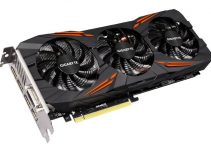
![Can Graphics Cards be Repaired? [Common Damages & Faults] Can Graphics Cards be Repaired? [Common Damages & Faults]](https://graphicscardhub.com/wp-content/uploads/2023/11/graphics-card-repair-211x150.jpg)
![Best GTX 1630 Cards for Budget and SFF PC [Low-power models] Best GTX 1630 Cards for Budget and SFF PC [Low-power models]](https://graphicscardhub.com/wp-content/uploads/2022/07/Gigabyte-GeForce-GTX-1630-OC-Low-Profile-4G-211x150.jpg)